Mosasaurus
Mosasaurus ("Lizard of the Meuse") is the type genus of mosasaurs (Mosasauridae), an extinct family of large marine reptiles from the Upper Cretaceous period. The genus gave its name to the Mosasauridae, pangolin crawlers that were highly adapted to an aquatic lifestyle. Mosasaurus was one of the last, most evolved and largest mosasaurs.
The skulls, found in the late years of the 18th century in a chalk quarry near the Dutch city of Maastricht, were the earliest fossils known to science. Originally, they were thought to be the bones of crocodiles or whales.
The first fossil, the skull of the holotype (NMHN AC. 9648), was found by Dutch miners near Maastricht in about 1770. After the invasion of French troops, the skull was brought to Paris in 1794 as spoils of war and gained notoriety with the nickname "great beast of Maastricht". In 1808, the naturalist Georges Cuvier concluded that it was a giant marine lizard with similarities to monitor lizards, but otherwise different from any animal known today. This view was revolutionary at the time and helped support the then-developing ideas of extinction of living things. Mosasaurus was thus the first reptile to be recognized as being a species from a pre-existing world that no longer existed. Previously, fossils were thought to be the remains of recent (or rather, unchanging) species. However, Cuvier did not give the new animal a scientific name; this was done by the British paleontologist William Daniel Conybeare in 1822, who named it Mosasaurus in reference to the fossil find near the Meuse River. The relationships between Mosasaurus and modern reptiles are disputed, and the question of whether its closest living relatives are monitor lizards or snakes remains part of scientific discourse.
Its skull, wider or narrower depending on the species, was equipped with robust jaws with large teeth and strong muscles that allowed a powerful bite. Its four extremities were shaped into sturdy paddles to steer the animal underwater. Its tail was long and ended in a paddle-like fin that curved downward. Mosasaurus was a predator that had a poor sense of smell, but excellent vision; also a high metabolic rate, indicating that it was endothermic (warm-blooded), which would make mosasaurs exceptional among pangolin crawlers. Classification of Mosasaurus has been historically problematic due to an unclear diagnosis of the type specimen. As a result, over fifty different species have been assigned to the genus in the past. A rediagnosis of the type specimen in 2017 helped resolve the taxonomy problem and confirmed that at least five species belong to the genus. An additional five species, still nominally classified in Mosasaurus, will be reexamined in a future study. Each species is characterized by unique anatomical features, from the robustly built M. hoffmannii to the slender and serpentine M. lemonnieri.
The type species and at the same time largest species of the genus, M. hoffmannii, probably reached nearly 18 meters total length. Gideon Mantell named the species in 1829 after the military surgeon Johann Leonard Hoffmann, who was supposedly involved in the recovery of the skull.
Fossil evidence suggests that Mosasaurus was widespread throughout much of the Atlantic Ocean and adjacent waters. Mosasaurus fossils have been found in North America, South America, Europe, Africa, western Asia, and Antarctica. This distribution spanned a wide range of oceanic climates, including tropical, subtropical, temperate, and subpolar. Mosasaurus was a common large predator in these oceans and a dominant species at the top of the food chain. Scientists believe it preyed on virtually any animal; its prey range included fish, sharks, cephalopods, birds, and other marine reptiles such as sea turtles and other mosasaurs. It probably preferred to hunt in open water near the surface. From an ecological perspective, Mosasaurus probably had a profound impact on the structure of marine ecosystems. Its distribution in some places, such as the Western Interior Seaway in North America, greatly altered the fauna. Although Mosasaurus competed with other large predatory mosasaurs such as Prognathodon and Tylosaurus that fed on similar prey, niche differentiation allowed the genera to coexist in the same ecosystems. Several fossils illustrated attacks on Mosasaurus individuals by Tylosaurus and by conspecifics. Presumably, rank fights took place in the form of biting, as seen today in crocodilians.

Live reconstruction of M. hoffmannii
Paleobiology
Musculature and functioning of the head
Much of what is known about the musculature and mechanics of the Mosasaurus head is based on Lingham-Soliar's 1995 study of M. hoffmannii skulls. Because soft tissues such as muscles do not fossilize easily, reconstruction of head musculature is based largely on the structure of the skull, the nature of muscle scarring on the skull, and the musculature of recent monitor lizards.
In modern lizards, the mechanical structure of the skull is characterized by a geometric structure with four pivot points in the skull, which allows flexible movement of the jaws, giving them advantages in hunting. However, the skull of M. hoffmannii is characterized by a more rigid cranial structure with three pivot points, indicating that jaw mechanics differed from modern lizards; its cranial structures are connected by strong interlocking sutures that can resist compressive and shear forces caused by a downward thrust of the mandibular muscles or an upward thrust of the prey. This rigid but strongly shock-absorbing structure of the skull probably allowed for a strong biting force during prey hunting.
As in all mosasaurs, the mandibles of Mosasaurus could swing forward and backward by adduction. In many mosasaurs, such as Prognathodon and M. lemonnieri, this function served mainly to convey prey into the pharynx with the pterygoid and jaws as if on a conveyor belt. However, especially compared to M. lemonnieri, the pterygoid teeth in M. hoffmannii are relatively small, indicating that this function was relatively unimportant in hunting and feeding. Rather, M. hoffmannii probably swallowed its prey whole and used jaw adduction to increase bite strength. The large adductor muscles (muscles that attach the mandible to the skull and play an important role in biting function) are massive, indicating that M. hoffmannii was capable of very powerful bites. The long, narrow, and heavy lower jaw and the tendons on the muscle processes allowed the mouth to open and close quickly with little energy input underwater, which also contributed to the strong bite force of M. hoffmannii; this suggests that the strong magnus depressor muscles (jaw opening muscles) that some plesiosaurs had would not be necessary at all.
Mobility and thermoregulation
Mosasaurus used its tail for locomotion. Probably the swimming style was subcarangiform (like for example in mackerels). Its elongated, paddle-like limbs were used for maneuvering, as in a hydrofoil. The steering function of the paddles was aided by a large muscle attachment from the outward-facing side of the humerus to the radius and ulna, as well as by an enhanced pronation capability made possible by modified joints. The strong forces generated by the use of the paddles could result in bone damage, as shown by a M. hoffmannii ilium with significant separation damage of the joint end and shaft, likely caused by frequent shear forces on the joint.
The tissue structure of Mosasaurus bones suggests that its metabolic rate was much higher than modern pangolin crawlers and that it had a basal metabolic rate between that of the leatherback turtle and that of ichthyosaurs and plesiosaurs. Judging from its high energy expenditure, Mosasaurus was probably endothermic. From studies of the biochemistry of related endothermic mosasaur genera such as Clidastes, it can be concluded that all mosasaurs were probably endothermic, although no studies of Mosasaurus exist. Such a trait is unique among pangolins, the only known exception being the seasonally endothermic black and white teju. Endothermy likely provided Mosasaurus with several advantages such as increased endurance when foraging in larger areas and when pursuing prey. It may also have allowed Mosasaurus to spread into colder climates such as Antarctica.
Sensory functions
Mosasaurus had relatively large eye sockets with large scleral rings occupying much of the diameter of the eye sockets. This suggests that Mosasaurus also had large eyes and good vision. The eye sockets were located on the sides of the skull, which provided a rather small binocular field of view of about 28.5 °, but provided a large overall field of view with excellent processing of a two-dimensional environment. Since Mosasaurus probably lived near the surface in open waters, it had little need for three-dimensional vision.
Grigoriev (2016) described a part of the inner ear of Mosasaurus using an incomplete fossil. The inner ear plays an important role in animal mobility, sensitivity, and balance. Mosasaur inner ears have been studied in the past, but exclusively with species outside the Mosasaurini. In Mosasaurus, the endpoints of the posterior and lateral arcades, which contribute to the control of the sense of balance, are separated; however, in other mosasaurs, the ends are fused, but this may be due to incomplete preservation of the fossils. The lateral archway is large, measuring 25.3 millimeters in a mosasaur 14 meters long. Unlike modern cetaceans, in which the archway size differs, this feature probably did not cause a difference in internal ear sensitivity in mosasaurs, since the proportions between archway size and skull length are very similar in modern monitor lizards and smaller mosasaurs such as Platecarpus.
Brain casts with Mosasaurus skulls show that the olfactory bulb and Jacobson's organ, which control olfactory function, are poorly developed and a number of components are missing in M. hoffmannii, suggesting that the species had an extremely poor sense of smell. In M. lemonnieri, these olfactory organs, although small, are better developed. This leads to the assumption that other senses, such as well-developed visual perception, were more useful.
Nutrition
Although there is little direct evidence of Mosasaurus' feeding habits, paleontologists generally agree that it was an active predator that hunted a variety of marine animals, including bony fish, sharks, cephalopods, birds, and marine reptiles such as other mosasaurs or turtles. Because of its poor sense of smell, it is unlikely that Mosasaurus was a scavenger. Mosasaurus was among the largest marine animals of its time, and with its large, robust, and sharp teeth, when fully grown it could probably prey on almost any animal. Lingham-Soliar (1995) suggested that Mosasaurus exhibited rather "ferocious" hunting behavior, as indicated by large tooth marks on grooves of the large sea turtle Allopleuron hoffmanni and fossils of broken and healed jaws in M. hoffmannii. The species probably hunted near the sea surface, spied prey with its large eyes, and attacked it from ambush. Chemical and structural data from the fossils of M. lemonnieri and M. conodon suggest that they may have hunted in deeper waters as well.
Carbon isotope studies on fossils of several M. hoffmannii individuals have found extremely low levels of δ13C, the lowest of any mosasaur. There are several implications for δ13C levels in mosasaur diets. The relationship between δ13C levels in mosasaurs and their trophic levels is negatively correlated. Mosasaurs with lower δ13C levels tended to occupy higher trophic levels. One factor in this is diet; prey such as sea turtles and other large marine reptiles rich in lipids can lower δ13C levels. The low δ13C level of M. hoffmannii suggests its position as an apex predator.
Currently, only one example of a Mosasaurus preserved with stomach contents is known: a well-preserved partial skeleton of a small M. missouriensis, which is about 75 million years old. Analysis of the stomach contents revealed the dismembered and punctured remains of a 1 meter long fish. This fish is much longer than the length of the 66-centimeter-long mosasaur skull, confirming that M. missouriensis chopped up its prey and devoured it in pieces. The presence of other large mosasaurs such as Prognathodon that specialized in strong prey and coexisted with M. missouriensis strongly suggests that, as an example of niche differentiation, the species likely specialized more in prey that it could capture well with its teeth adapted for cutting.
A find of the fossil nautiloid Argonautilus catarinae with bite marks from two conspecific Mosasaurus, one from a juvenile and the other from an adult, may indicate that Mosasaurus taught its offspring to hunt. Analysis of the tooth marks indicated that they were from either Mosasaurus or Platecarpus. The positioning of both bite marks is in the direction in which the nautiloid was pointing, indicating that it could not escape and was therefore already sick or dead during the attacks. It is possible that this phenomenon originated from a mosasaur teaching its offspring that cephalopods were an alternative source of prey and how to hunt them. An alternative explanation is that the bite marks are from a single mosasaur that first bit into the animal lightly and then bit again with greater force. However, differences in tooth spacing between the two bites indicate different jaw sizes, making the first hypothesis more likely.
Intraspecific fight
There is fossil evidence that Mosasaurus engaged in aggressive and lethal fights with other individuals of the same species. A partially preserved M. conodon fossil showed multiple cuts, fractures, and punctures to various bones, particularly in the posterior portions of the skull and neck, as well as a tooth of another M. conodon individual in the os quadratum. The fossil's injuries show no signs of healing, indicating that the mosasaur was killed by its attacker by a bite to the skull. Another example is a M. missouriensis skeleton with a tooth from another M. missouriensis stuck in the lower jaw below the eye. In this case, there was evidence of healing around the wound, indicating that the victim survived the incident. However, Konishi suggested an alternative explanation, bites to the head during courtship, as is the case with modern lizards. There are several other known fossils of Mosasaurus skulls that show evidence of severe injuries, some of which were probably fatal or resulted in infections and were probably caused by attacks by other Mosasaurus. Another possible explanation for some of these injuries is an attempt to bite hard turtle shells. It is noticeable that many of the injuries are concentrated in the skull; this may indicate that Mosasaurus used head attacks during intraspecific combat, as do modern crocodilians (which attack other crocodilians by holding their opponent's head with their jaws). Many of the fossils with injuries possibly due to intraspecific fighting are from juvenile or subadult Mosasaurus, raising the possibility that attacks on smaller, weaker specimens were more common. However, the attacking individuals of M. conodon and M. missouriensis were likely similar in size to the victims. Some scientists speculate that Mosasaurus was occasionally cannibalistic.
Course of life
It is likely that Mosasaurus was viviparous. There is no evidence of viviparity in Mosasaurus itself, but it is known in some other mosasaurs: Examples include a skeleton of the pregnant basal mosasaurid Carsosaurus, a Plioplatecarpus fossil associated with the fossils of two mosasaur embryos, and fossils of newborn Clidastes from pelagic deposits. Such fossil assemblages, together with the complete absence of any evidence of oviposition, argue for viviparity in Mosasaurus. Microanatomical studies of bones of juvenile Mosasaurus and related genera revealed that their bone structures were comparable to those of adults and showed no increase in bone mass, as has been noted in juvenile primitive mosasaurids to support buoyancy when living in shallow water; this implies that Mosasaurus was a nest fledger. Even at a very young age, they were efficient swimmers with functional open water life; this did not require separate nursery areas. However, aggregations of juvenile M. hoffmannii, M. missouriensis, and/or M. lemonnieri have been found at some sites in Europe and South Dakota. These localities are exclusively shallow ocean deposits, suggesting that juvenile Mosasaurus may have resided in shallow water.
Paleopathology
With its apparent "wild" lifestyle, there are a number of known fossils of M. hoffmannii that exhibit severe physically induced damage. Two examples are IRSNB R25 and IRSNB R27 from the Royal Belgian Institute of Natural Science, both of which show fractures and other damage in their tooth bones. IRSNB R25 exhibits a complete fracture near the sixth tooth compartment. Surrounding the fracture are extensive amounts of bony callus growing almost beyond the tooth compartment, as well as various osteolytic cavities, abscess canals, damage to the trigeminal bone, and inflamed erosions indicating severe bacterial infection. There are two finely suppurated scratches on the bone callus that may have developed during the healing process. Specimen IRSNB R27 has two fractures: One is almost completely healed and the other is an open fracture with nearby teeth broken off. The fracture is covered with pseudarthrosis of a bone callus with shallow scrape marks and a large pit associated with an abscess channel. Both specimens show evidence of deep bacterial infection in addition to the fractures. Some bacteria may have spread to nearby damaged teeth, causing caries that may have invaded deeper tissues from previous post-traumatic or secondary infections. However, the teeth before the fractures are in good condition in both specimens, suggesting that arteries and trigeminal nerve were not damaged. If they had been, these body parts would have necrotized due to lack of blood. The condition of the teeth suggests that there may have been an efficient process to immobilize the fracture during healing, which may have helped prevent damage to vital blood vessels and nerves. This, along with evidence of healing, also implies that the fractures were not immediately fatal. The cause of the injuries cannot be determined with certainty; however, there are two possibilities. One possibility could have been collateral damage from a bite on a hard surface such as a turtle shell, which would have caused increased stress on the jaw bones. Another possibility is injury from a conspecific during a fight. The pit in IRSNB R27 was described as "resembling a tooth track," raising the possibility that it was the result of an attack by another mosasaur.
In 2006, Schulp et al. published a study describing a fossil quadrate leg of M. hoffmannii with a massive chronic infection. The bone was severely damaged, had multiple unnatural openings, and an estimated half liter (0.5 kg) of bone tissue was destroyed. It is likely that this was the result of a severe bone infection caused by septic arthritis that had progressed to the point where a large portion of the square leg was reduced to an abscess. Extensive amounts of bone repair tissue were also present, suggesting that the infection and subsequent healing process may have continued for several months. This extent of bone infection would likely have been extremely painful and severely impaired the animal's ability to use its jaws. The location of the infection could also have affected breathing. Considering that the individual was able to survive such conditions for an extended period of time, it is likely that it adapted and hunted soft-bodied prey such as squid that could be swallowed whole to minimize jaw use. The cause of the infection remains unknown; however, if an attack by a conspecific was the cause, it is possible that one of the openings on the quadrate bone was the entry wound of a tooth from which the infection entered.
Many studies have reported that bone necrosis was found in every M. lemonnieri and M. conodon specimen examined. In studies of M. conodon fossils from Alabama and New Jersey and M. lemonnieri fossils from Belgium, Rothschild and Martin (2005) observed that between 3% and 17% of Mosasaurus vertebrae were affected by this condition. Bone necrosis is a common consequence of decompression sickness; during deep or repetitive diving, decompressed inhalation air leads to the formation of gaseous nitrogen bubbles that cause bone damage. This indicates that bothMosasaurus species dove either frequently deep or frequently repetitively. Agnete Weinreich Carlsen noted that it would be inappropriate to consider the occurrence of such conditions as a result of a failure of the animal's anatomy to adapt, since fossils of other mosasaurs also suffering from bone necrosis show evidence of a developed tympanic membrane, which protected them well during rapid pressure changes.
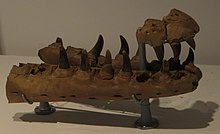
M.hoffmannii fossil IRSNB R25 with an infected fracture on the left tooth (seen between the two middle tooth crowns on the back).

Fragmentary skull of a juvenile Mosasaurus (NHMM 200793) from Geulhem, The Netherlands.
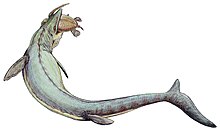
M. hoffmannii preys on a sea turtle
_(14780145004).jpg)
Like modern crocodiles, Mosasaurus probably grabbed his opponent's head during the fight.
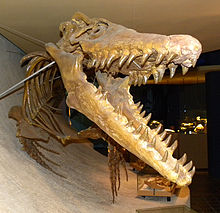
The skull of M. hoffmannii was adapted to withstand strong bites.
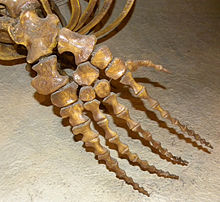
Reconstruction of a forelimb of M. hoffmannii

Mosasaurus scleral ring
Paleoecology
Distribution, ecosystem and ecological impact
With the exception of Pacific species not studied by Street and Caldwell (2017), which were identified as separate genera by Street (2016), Mosasaurus was a transatlantic mosasaur whose fossils were found in marine deposits on both sides of the Atlantic Ocean. These locations include the Midwest and East Coast of the United States, Canada, Europe, Turkey, Russia, the Levant, the African coast from Morocco to South Africa, Brazil, Argentina, and Antarctica. During the Late Cretaceous, the above regions formed the three seaways inhabited by Mosasaurus: the Atlantic Ocean, the Western Interior Seaway, and the Tethys Sea. They encompassed several oceanic climatic zones, including tropical, subtropical, temperate, and subpolar. The wide range of oceanic climates resulted in a great diversity of fauna that coexisted with Mosasaurus.
Tethys Sea
The Tethys Sea was located in what is now Europe, Africa, and the Middle East during the Maastrichtian. Recent paleographic studies show that it also extended across the Atlantic, including Brazil and the East Coast state of New Jersey. It is geographically divided into two faunal provinces, each encompassing the northern and southern Tethys margins. From an ecological perspective, the two mosasaurs Mosasaurus and Prognathodon appear to be the dominant taxa of the entire seaway, as they were widespread and ecologically diverse throughout the Mediterranean. The northern Tethys margin was located around the paleolatitude of 30-40 °N and consisted of what is now the European continent, Turkey, and New Jersey. At this time, Europe consisted of a collection of islands, with most of the present-day continental landmass underwater. A warm-moderate climate existed on the northern Tethys margin, with habitats dominated by mosasaurs and sea turtles. M. hoffmannii and Prognathodon sectorius were the dominant species in the northern province. Other mosasaur species such as M. lemonnieri were the dominant species in certain areas such as Belgium. Other mosasaurs found on the European side of the northern Tethys margin include smaller genera such as Halisaurus, Plioplatecarpus, and Platecarpus, the shell-eater Carinodens, and larger mosasaurs with similar trophic levels, including Hainosaurus and four other Prognathodon species. Marine turtles such as Allopleurodon hoffmanni and Glyptochelone suickerbuycki were common in the region, and other marine reptiles, including undetermined elasmosaurs, were occasionally found. Marine reptile finds from the New Jersey region are essentially the same as those in Europe, but without M. lemonnieri, Carinodens, Tylosaurus, and certain species of Halisaurus and Prognathodon. Instead, M. conodon, Halisaurus platyspondylus, and Prognathodon rapax are included. Many species of sharks such as Squalicorax, Cretalamna, Serratolamna, and sand sharks, as well as bony fishes such as Cimolichthys, the long-toothed Enchodus, and the swordfish-like Protosphyraena lived on the northern Tethys margin.
The southern Tethys margin extended along the equator between 20 °N and 20 °S and therefore included warmer tropical climates. At the cratons in Africa and Arabia, located around present-day Africa, Arabia, the Levant, and Brazil, the shallow seafloor extended widely. This region was also dominated by mosasaurs and sea turtles. Globidens phosphaticus is the characteristic species of the southern region among the mosasaurs; in the African and Arabian areas, Halisaurus arambourgi and 'Platecarpus ptychodon' (a doubtful taxon that includes various mosasaurs such as Gavialimimus or Platecarpus somenensis) were the most common mosasaurs. Mosasaurus was less common here: M. beaugei was restricted to Morocco and Brazil, and isolated teeth from Syria indicated a possible occurrence of M. lemonnieri; in addition, M. hoffmannii also occurred throughout the province. Other mosasaurs from the southern Tethys margin include Goronyosaurus, the shell-eaters Igdamanosaurus and Carinodens, Eremiasaurus, four other species of Prognathodon, and several other species of Halisaurus. Apart from Zarafasaura in Morocco, plesiosaurs were scarce, but other marine reptiles such as the marine monitor Pachyvaranus and the sea snake Palaeophis occurred. Bony fishes such as Enchodus and Stratodus and various sharks were also common along the southern Tethys margin.
Western Interior Seaway
Many of the earliest fossils of Mosasaurus were found in the Campanian Stage in North America. This includes the former Western Interior Seaway, an inland sea that flowed through what is now the United States and Canada, connecting the ArcticOcean to what is now the Gulf of Mexico. The region was rather shallow, with a depth of about 800 to 900 meters at its deepest point. The drying of the neighboring continents of Appalachia and Laramidia produced a large amount of sediment. Continental fresh water mixed with Arctic water from the north and warmer salt water from the Tethys Sea to the south. The warm, nutrient-rich, and deep waters provided a habitat for a variety of different marine life. The biogeography of the region was generally divided into two interior subprovinces characterized by distinct climates and faunas that bordered present-day Kansas. The oceanic climate of the northern subprovince was probably cool and temperate, while the southern subprovince had a warm, temperate to subtropical climate. Fossil assemblages in these regions at the time of M. missouriensis and M. conodon occurrence indicate that Mosasaurus had a profound impact on marine ecosystems in the Western Interior Seaway. The fauna of both provinces was generally much more diverse prior to the appearance of Mosasaurus. These periods of diversity are referred to as the Niobrara Ages. During this time, the northern subprovince was dominated by plesiosaurs, seabirds of the Hesperornithiformes, and the mosasaur genus Platecarpus. In contrast, in the southern subprovince, where all animal groups were much more diversely represented than in the north, sharks, turtles, and a wide variety of mosasaurs such as Tylosaurus and Clidastes were the dominant animal groups.
The appearance of M. missouriensis and M. conodon in the Western Interior Seaway 79.5 million years ago coincided with the transition to the subsequent Navesink Age, which was accompanied by the collapse of the Niobrara fauna and a complete renewal of marine faunal structure. In present-day Alabama in the southern subprovince, most key genera, including the mosasaurs Clidastes, Tylosaurus, Globidens, Halisaurus, and Platecarpus, as well as sharks such as Cretoxyrhina, disappeared and were replaced by Mosasaurus. The overall diversity of marine reptiles decreased considerably until eventually Mosasaurus dominated the entire region and accounted for about two-thirds of the total diversity of mosasaurs, with Plioplatecarpus and Prognathodon together making up the remaining third. In the northern subprovince, the beginning of the Navesink age also saw a restructuring of the mosasaur deposits, with mosasaurs such as Platecarpus and replaced by Mosasaurus and Plioplatecarpus. Niobrara genera such as Tylosaurus, Cretoxyrhina, Hesperornithiformes, and plesiosaurs, including elasmosaurs such as Terminonatator and polycotylids such as Dolichorhynchops, remained present until near the end of the Campanian, while the entire Western Interior Seaway declined from the north. Mosasaurus continued to be the dominant genus until the end of the Navesink Age at the end of the Cretaceous. Nevertheless, there were a variety of animals that coexisted with Mosasaurus. These included sea turtles such as Protostega and Archelon, many species of seabirds including Baptornis, Ichthyornis, and Halimornis, crocodiles such as Deinosuchus, and many genera of fish including sharks such as the mackerel sharks Cretalamna, Squalicorax, Pseudocorax, and Serratolamna, the goblin shark-like Scapanorhynchus, Odontaspis, and the sawfish Ischyrhiza, and bony fishes such as Enchodus, Protosphyraena, Stratodus, and the ichthyodectiformes Xiphactinus and Saurodon.
Antarctica
Mosasaurus is known from late Maastrichtian deposits on the Antarctic Peninsula, particularly from the López-de-Bertodano Formation on Seymour Island. It is estimated that this site was located at about 65° south latitude in the Antarctic Arctic Circle during the Maastrichtian period and probably provided a rather unique climate. Chemical studies of oxygen-18 isotopes in shells and benthic foraminifera revealed average depth and deep-sea ocean temperatures of 6°C with variations of 4 to 12°C throughout the Maastrichtian; however, sea surface temperatures may have been colder, possibly falling below freezing and forming sea ice at times. A study using data from prehistoric bacterial membrane lipids found a slightly warmer temperature of 12 ± 5 °C for the period 66 million years ago. Nevertheless, these estimated climates characterize a mainly cool-temperate environment with possible subpolar and warm episodes.
At least two species of Mosasaurus have been described from Seymour Island, but the actual number of species is unknown because remains are often fragmentary and specimens are described without precise identification. These species include one with affinity to M. lemonnieri and another that appears to be closely related to M. hoffmannii. A number of Mosasaurus fossils known from the region are considered too fragmentary to be identified to species level. Nevertheless, the genus appears to have been the most taxonomically diverse in Antarctica during the Maastrichtian. Mosasaurus is not the only mosasaur from Seymour Island; at least four other genera have been discovered at similar or identical sites, including Plioplatecarpus, Moanasaurus, Liodon, and Kaikaifilu. However, many of these finds are based primarily on isolated teeth, and studies of the dental variability of Kaikaifilu indicated that it is possible that more genera were identified than were actually present. Prognathodon and Globidens are also expected based on their distributional ranges, although no definite fossils have yet been found. Other marine reptiles of this region included elasmosaurid plesiosaurs such as Aristonectes, as well as another undetermined genus. The fish assemblage of the López-de-Bertodano Formation was dominated by Enchodus and Ichthyodectiformes, which accounted for 21.95% and 45.6% of the local fish diversity, respectively. Sand sharks accounted for 10.5%, the combtooth shark Notidanodon 6.8%, sea cats 3.9%, saw sharks 2.7%, various other bony fishes 2.4% and the remaining 6% was shared by other sharks such as Paraorthacodus, Ruffed sharks, Protosqualus and Cretalamna.
Preferred habitat
A traditional method for determining the habitat preference of fossil animals is to determine the habitat represented by the deposits from which they are derived. Known fossils of Mosasaurus were typically recovered from deposits representing nearshore habitats during the Cretaceous, with some fossils from deeper marine layers. Lingham-Soliar (1995) determined that Maastrichtian deposits in the Netherlands containing M. hoffmannii fossils represent nearshore waters approximately 40-50 meters deep. Changing temperatures and abundance of marine life were characteristic of these localities. However, the morphological makeup of M. hoffmannii was best suited to a pelagic surface lifestyle. The animals probably stayed near the surface, where they benefited from the abundance of their prey.
A more recent approach is biogeochemical analysis, one of which is the measurement of δ13C levels in tooth enamel. A known correlation with δ13C values indicates that carbon isotope concentrations typically decrease as the animal's habitat moves farther from shore. Studies of several Mosasaurus fossils consistently indicate that Mosasaurus lived in nearshore or open waters. However, other factors in the animal's lifestyle also affected δ13C levels, suggesting that isotope levels may misrepresent actual habitat preferences of Mosasaurus; for example, the Bohr effect of diving may have been different in M. hoffmannii than in M. lemonnieri and M. conodon. As a solution, paleontologists T. Lynn Harrell Jr. and Alberto Perez-Huerta conducted a study in 2014 that specifically examined the concentration ratios of neodymium, gadolinium, and ytterbium in various Mosasaurus fossils from Alabama and New Jersey. Previous studies showed that the ratios of these three elements can serve as an indicator of a fossil's relative ocean depth during early diagenesis without disturbance from biological processes, with each of the three elements signifying either shallow, deep, or fresh water. Rare earth ratios were very constant in most Mosasaurus fossils examined, indicating a consistent habitat preference for nearshore habitats with ocean depths of at least 50-150 meters. Some divergent values indicated shallower waters with depths of 50 meters or less.
Competition with related genera
Mosasaurus shared its habitat with other large predatory mosasaurs that are also considered apex predators, including the Tylosaurinae and Prognathodon. Tylosaurus bernardi, the only species of the genus still extant during the Maastrichtian, measured up to 12.2 meters, and the largest Prognathodon species, such as P. saturator, also reached over 12 meters in length. These three mosasaurs preferred similar prey, especially other marine reptiles.
A carbon isotope study published in 2013 by Schulp and colleagues examined how mosasaurs such as M. hoffmannii and P. saturator were able to coexist in the same habitats. Differences in isotopic values were able to explain the extent of resource partitioning, which is influenced by several environmental factors such as lifestyle, diet, and habitat preference. Comparisons between δ13C levels in several teeth of M. hoffmannii and P. saturator from the Maastrichtian Formation showed that although there was some convergence between certain specimens, the average of the values between the two species were generally different. This is indicative of niche differentiation, where the two mosasaur genera likely foraged in different habitats or had different prey preferences in order to coexist without direct competition. The morphological structure of the two species supports this assumption. The teeth of P. saturator are much more robust than those of M. hoffmannii and were adapted for hunting robust prey such as turtles. Even though M. hoffmannii also hunted turtles, its teeth were suitable for hunting a wider range of prey that were probably unsuitable for P. saturator.
Another case of presumed niche differentiation between Mosasaurus and Prognathodon overtoni from the Bearpaw Formation in Alberta was documented in a 2014 study by Konishi et al. in which fossil stomach contents were examined. Turtles and ammonites, were found in the stomach of P. overtoni, supporting the thesis for a diet specialized for harder prey. In contrast, the stomach contents of M. missouriensis consisted of fish, indicating a diet specialized for softer prey.
However, an interspecific rivalry could apparently not be avoided completely. Thus, there is also evidence of aggressive fighting between Mosasaurus and other large mosasaur genera. A fossil skull of a subadult M. hoffmannii had fractures caused by a massive concentrated blow to the braincase; Lingham-Soliar (1998) argued that this blow was caused by a ramming attack by Tylosaurus bernardi, since the formation of the fractures was characteristic of a coordinated strike (rather than an accident or damage during fossilization) and that T. bernardi was the only known coexisting animal likely capable of such damage with its robust, projectile-like elongated rostrum. This type of attack has been compared to the defensive behavior of bottlenose dolphins that use their beaks to kill or repel lemon sharks, and it has been suggested that T. bernardi executed the ambush attack on Mosasaurus.
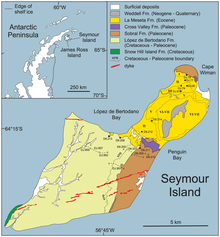
Mosasaur fossils were found on Seymour Island in Antarctica, which was once surrounded by cool temperate water.
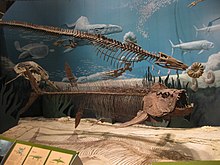
Mosasaurus existed in North America alongside bony fishes such as Xiphactinus, sea turtles such as Protostega, and mosasaurs of the family Plioplatecarpinae.
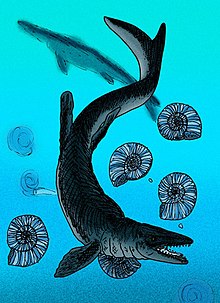
Mosasaurus inhabited nearshore habitats at various depths.

Mosasaurus was able to coexist with other large predatory mosasaurs such as Prognathodon through niche differentiation.
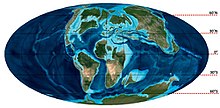
Mosasaurus lived in the Western Interior Seaway of North America and in the Tethys Sea of Europe and Africa.

Restoration of M. beaugei, known from Morocco and Brazil.
Questions and Answers
Q: What are Mosasaurs?
A: Mosasaurs were large, predatory marine lizards from the Upper Cretaceous period.
Q: Where was the first fossil Mosasaur found?
A: The first fossil Mosasaur, Mosasaurus hoffmanni, was found in the Netherlands.
Q: When was the first fossil Mosasaur named?
A: The first fossil Mosasaur, Mosasaurus hoffmanni, was named in 1822 by W.D. Conybeare.
Q: What is the Upper Cretaceous period?
A: The Upper Cretaceous period is the third and final epoch of the Cretaceous period, which lasted from about 99.6 to 66 million years ago.
Q: What was the size of Mosasaurs?
A: Mosasaurs were large in size.
Q: Were Mosasaurs marine or terrestrial animals?
A: Mosasaurs were marine animals.
Q: Are there any living descendants of Mosasaurs?
A: No, Mosasaurs are extinct and have no living descendants.
Search within the encyclopedia